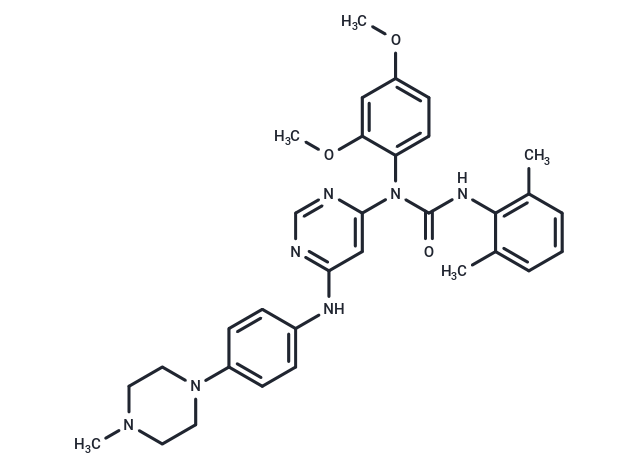Shopping Cart
- Remove All
 Your shopping cart is currently empty
Your shopping cart is currently empty

HG-9-91-01 (SIK inhibitor 1) is a potent and highly selective salt-inducible kinase (SIKs) inhibitor with IC50s of 0.92 nM, 6.6 nM and 9.6 nM for SIK1, SIK2 and SIK3respectively.

| Pack Size | Price | Availability | Quantity |
|---|---|---|---|
| 1 mg | $76 | Backorder | |
| 2 mg | $97 | Backorder | |
| 5 mg | $163 | Backorder | |
| 10 mg | $289 | Backorder | |
| 25 mg | $483 | Backorder | |
| 50 mg | $693 | Backorder | |
| 100 mg | $988 | Backorder | |
| 1 mL x 10 mM (in DMSO) | $197 | Backorder |
| Description | HG-9-91-01 (SIK inhibitor 1) is a potent and highly selective salt-inducible kinase (SIKs) inhibitor with IC50s of 0.92 nM, 6.6 nM and 9.6 nM for SIK1, SIK2 and SIK3respectively. |
| Targets&IC50 | SIK1:0.92 nM, SIK2:6.6 nM, SIK3:9.6 nM |
| In vitro | HG-9-91-01, a recently identified inhibitor of SIK1-3 and various other kinases, targets numerous protein tyrosine kinases with a threonine residue at their gatekeeper site, including members of the Src family (Src, Lck, and Yes), BTK, and the FGF and Ephrin receptors. This compound has been shown to significantly inhibit SIK2, thereby enhancing IL-10 production, with effects akin to those observed with PGE2 treatment—demonstrating potentiation of zymosan-induced IL-10 production in a concentration-dependent manner with an EC50 of approximately 200 nM. Moreover, HG-9-91-01 exhibits over 100-fold greater potency against SIKs compared to AMPK in cell-free assays (IC50=4.5 μM). Additionally, treatment with HG-9-91-01 leads to a dose-dependent increase in mRNA expression of Pck1 and G6pc, paralleling the effects of 0.1 μM glucagon, and consequently results in elevated glucose production. |
| Cell Research | Bone marrow is harvested from femurs and tibias of C57BL/6 mice. Bone-marrow-derived dendritic cells (BMDCs) are differentiated DMEM supplemented with 2 mM GlutaMAX, 10% (vol/vol) FBS, Penicillin, Streptomycin, and 2% mouse granulocyte-macrophage colony-stimulating factor (GM-CSF)-conditioned media derived from murine L cells. Cultures are differentiated for 7 d and routinely analyzed for >90% CD11c (allophycocyanin (APC) anti-CD11c clone HL3) positivity by flow cytometry before use in experiments. Lentiviral transduction of bone marrow cultures is conducted by addition of 293T culture supernatants containing lentiviral particles encoding the CREB-dependent luciferase reporter construct or CRTC3 targeting or control shRNAs 1 d postisolation. Stable integration of lentiviral shRNA constructs is selected by addition of puromycin (3 μg/mL) on day 4 posttransduction. After 2 d, stably transduced BMDCs are released from selection and used in subsequent assays. Unless otherwise indicated, cells are treated for 2 d with PGE2 (5 μM) or HG-9-91-01 (0.5 μM) or an equivalent concentration of DMSO (≤0.5%) and then stimulated for 18 h with LPS (100 ng/mL), R848 (10 μg/mL), or Zymosan (4 μg/mL)[2]. |
| Alias | SIK inhibitor 1 |
| Molecular Weight | 567.68 |
| Formula | C32H37N7O3 |
| Cas No. | 1456858-58-4 |
| Smiles | COc1ccc(N(C(=O)Nc2c(C)cccc2C)c2cc(Nc3ccc(cc3)N3CCN(C)CC3)ncn2)c(OC)c1 |
| Relative Density. | 1.257 g/cm3 (Predicted) |
| Storage | Powder: -20°C for 3 years | In solvent: -80°C for 1 year | Shipping with blue ice. | ||||||||||||||||||||||||||||||
| Solubility Information | 30% propylene glycol plus 70% ethanol: Soluble DMSO: 50 mg/mL (88.08 mM), Sonication is recommended. | ||||||||||||||||||||||||||||||
Solution Preparation Table | |||||||||||||||||||||||||||||||
DMSO
| |||||||||||||||||||||||||||||||

Copyright © 2015-2025 TargetMol Chemicals Inc. All Rights Reserved.